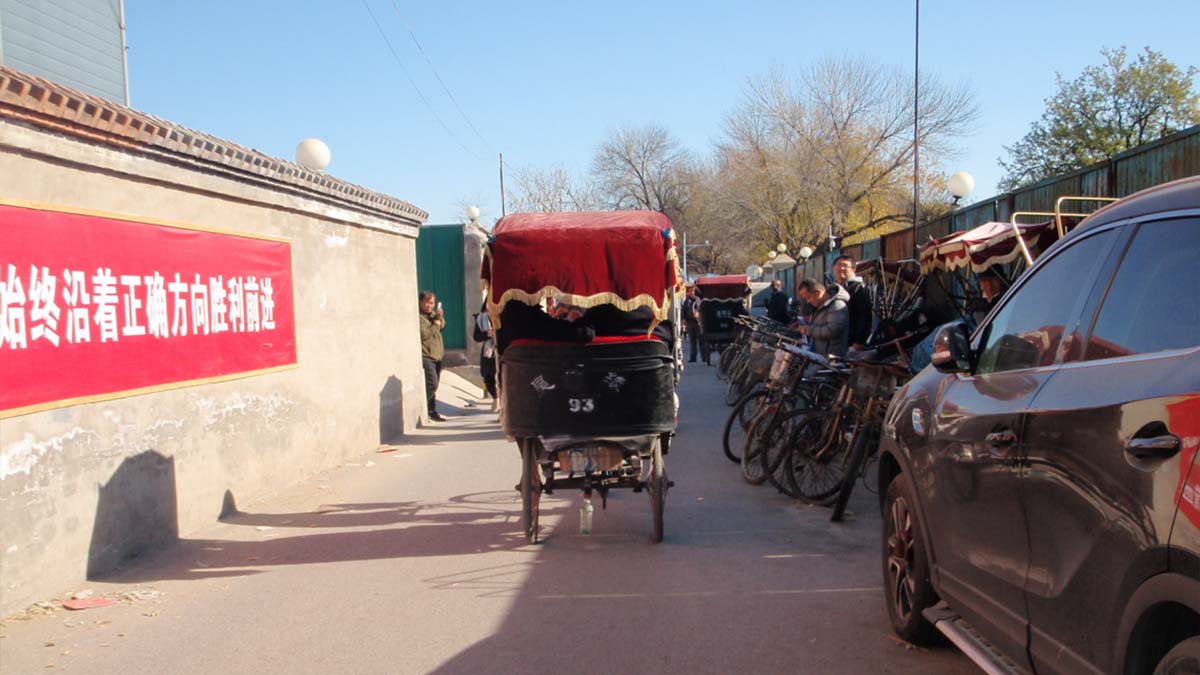
by Leslie Hebert
The young rickshaw driver in the bright blue jacket bore down on the pedals of his bike to get us moving. My husband and I, definitely not small people, were squeezed tightly into the seat of a small carriage behind the bike. Bundled in a threadbare black and red plaid blanket, we squirmed uncomfortably in our narrow conveyance. I calculated the burden of our combined weight, thinking that perhaps our driver was not going to be strong enough to move us, but he made one final push and we began to roll forward.
Push, groan, squeak.
The ancient bike creaked and moaned as its driver huffed and puffed, his breath making dragon-like clouds of steam in the cold November air. The icy wind whistled down the narrow street, I buried my hands in the blanket for warmth, and we followed a long line of red-canopied rickshaws through the narrow alleys of the Hutong District in old Beijing.
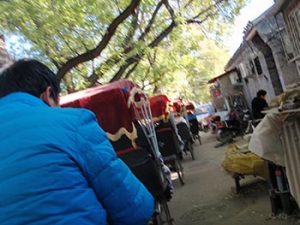 Local residents smiled in amusement and waved at the parade of foreigners passing by as the rickshaw convoy picked up a surprising amount of speed. We sped through the alleys, narrowly missing scooters and taxis coming from the opposite direction. Above my head, completely out of context, I was astonished to see a shipping container hanging in the air. Being from the port city of Vancouver, I am used to seeing containers sitting on barges, at the dockside, or behind trucks on the highway, but I had never seen one on top of a residential building. Yet here, in this overcrowded district of one of the world’s largest, most populous cities, one had been creatively converted into a second floor apartment.
Local residents smiled in amusement and waved at the parade of foreigners passing by as the rickshaw convoy picked up a surprising amount of speed. We sped through the alleys, narrowly missing scooters and taxis coming from the opposite direction. Above my head, completely out of context, I was astonished to see a shipping container hanging in the air. Being from the port city of Vancouver, I am used to seeing containers sitting on barges, at the dockside, or behind trucks on the highway, but I had never seen one on top of a residential building. Yet here, in this overcrowded district of one of the world’s largest, most populous cities, one had been creatively converted into a second floor apartment.
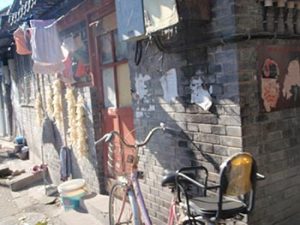 The rickshaws brought us to our lunch destination, a noodle house in the home of a local resident. The tour group, all 30 of us, filed through a tiny kitchen, where freshly cut vegetables lay ready for stir frying, and crowded into a small living room to squat on low stools, elbow to elbow, ten to a table. There was little warmth in the house, but the combined heat of thirty crammed bodies and the heat of the green tea our hostess served were a comforting relief from the cold outside.
The rickshaws brought us to our lunch destination, a noodle house in the home of a local resident. The tour group, all 30 of us, filed through a tiny kitchen, where freshly cut vegetables lay ready for stir frying, and crowded into a small living room to squat on low stools, elbow to elbow, ten to a table. There was little warmth in the house, but the combined heat of thirty crammed bodies and the heat of the green tea our hostess served were a comforting relief from the cold outside.
Plates of food arrived and we happily shared noodles, bean sprouts, summer squash, chicken legs and delicious fried peanuts. I relaxed. Warmth flowed through my body and down into my fingers, and I leaned comfortably back against the flaking, whitewashed wall behind me to savour more hot tea. Then just as I got comfortably warm the guide abruptly announced it was time to go, and I was reminded that we were on a tight tour schedule
As I headed back out into the chill November air the hostess and cook, who were standing in the kitchen to see us off, grabbed me and started laughingly swatting whitewash from the back of my black coat. Smiling and nodding, I extricated myself as politely as possible and caught up with the group making its way back to the rickshaws.
Our next stop was a traditional courtyard house, built to accommodate the many members of a traditional extended family. This was a large sprawling house, a maze which seemed to contain at least three courtyards each surrounded by long, low buildings containing various storage, sleeping and common rooms.
The owner of the house was a piece of living history, a genial, round-faced 99 year-old who stood in the open doorway of one of the rooms waving us in. I smiled and greeted him with a polite “ni hao” but, being completely deaf, he smiled and nodded vacantly and beckoned to the next person. I walked out across the chill of the courtyard and escaped from the freezing wind once more by squishing into the main living room with the rest of the group. I sank down into the warm embrace of a low, soft couch placed against the wall. Someone perched on the arm of the couch, people sat on rows of rickety folding chairs lined up in front of the couch, and others crowded into the doorway.
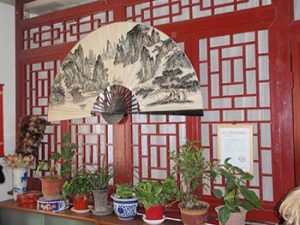 Against a red wooden fretwork on the far wall hung a giant fan. To my left was a floor to ceiling bookcase stuffed with musty old books, and in the centre of the room stood a dark wooden coffee table covered with piles of photo albums and a miscellany of old black and white photographs.
Against a red wooden fretwork on the far wall hung a giant fan. To my left was a floor to ceiling bookcase stuffed with musty old books, and in the centre of the room stood a dark wooden coffee table covered with piles of photo albums and a miscellany of old black and white photographs.
The guide passed some of the photos around and told us that the old man who now lived in the house with his son and grandson had made his fortune in the 1930s, midway between the fall of the Ching dynasty and the rise of Chairman Mao. With his new-found wealth he had bought the house we were sitting in for three one-kilogram bricks of gold.
One of the faded photo passed around showed two young girls and two small boys standing in front of the house. They were dressed in traditional Chinese clothing. The girls had long braids, and wore quilted jackets with pretty floral patterns. Each of the four children stood in a different pose, as if caught in an instant between bouts of energetic play. In the second photo, four older children stood sternly at attention, all sporting identical short haircuts and identically dressed in peaked caps and thin denim “Mao suits”, the uniform of the Cultural Revolution.
Chairman Mao began the Cultural Revolution in the 1960s by removing all his political opposition. In 1966 he shut down the schools and many of the now idle students joined units of the Red Guard, a paramilitary organization that persecuted the elderly and intellectuals, and battled for power with other Guard units. By the fall of 1967 anarchy loomed in many cities and the economy was failing. After lengthy power struggles between various factions, China achieved stability once more, but the economic and human cost of the Cultural Revolution had been high. Millions were imprisoned, many were tortured or had their property seized, and 1.5 million were killed.
“Look at these children,” said the guide. “They are smiling and mischievous. They are normal, happy human beings. Now look at these same children a few years later, how sad and serious they are. Before, they were individuals. They all dressed differently and wore bright colours. Now they are soldiers of Mao. They are all dressed the same. See how sad they look!”
“Life under Mao,” he added, “was 28 years of hell.”
Members of the tour group began to fire questions at him.
“So why is Mao still honoured?”
“Why is his picture displayed?”
“Why is he still portrayed on the money?”
“Isn’t China still Communist?”
He explained that the People’s Republic had evolved into a mixed economy, part socialist, part capitalist, but that Mao was still honoured as the founder of the current system and because the current administration was part of his legacy.
Yes, indeed. In the new China I had seen clear evidence of capitalist activity such as private banks, luxury hotels and fast food franchises like KFC and Starbucks. But I also sensed a tense undercurrent. I had seen security everywhere, sometimes unobtrusive videocam surveillance and sometimes more obvious groups of police officers, and there were unbelievably thorough security checks at every national monument.

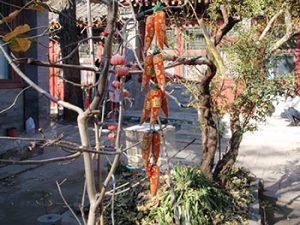 Leaving the cosiness of the living room for the chill air outside, I crossed the uneven surface of the courtyard past bare fruit trees and the remains of the summer vegetable garden. Two gourds clung to life on the branches of a dying vine and a string of artificial chili peppers made from shiny red and gold fabric hung from a bare branch like an enormous yet bizarre Christmas decoration.
Leaving the cosiness of the living room for the chill air outside, I crossed the uneven surface of the courtyard past bare fruit trees and the remains of the summer vegetable garden. Two gourds clung to life on the branches of a dying vine and a string of artificial chili peppers made from shiny red and gold fabric hung from a bare branch like an enormous yet bizarre Christmas decoration.
Out in the alley the rickshaws with their gold fringed red canopies and cramped seats were lined up waiting to return us to the warm spacious luxury of the tour coach taking to the airport.
As we sped back through the Hutong District, I sat rubbing warmth back into my chilled fingers, anticipating the short flight south, and looking forward to the milder climate of Shanghai.
If You Go:
I recommend going to Beijing in the spring or early fall. It was surprisingly cold in November and can also be unbearably hot in summer.
Although the Hutong tour was part of our tour itinerary, independent travellers can book a similar tour through their hotel. Rickshaw, group and private walking tours are available. They vary in length from 4 to 8 hours and prices range from $US 49 to $US 69. You can read more information at www.tour-beijing.com/hutong/#.Wh9eODD_q1s
About the author:
Lesley Hebert is a graduate of Simon Fraser University. Now retired from teaching English as a second language in the classroom, she teaches ESL to international students via Skype. She also writes on-line articles which reflect a lively, inquiring mind and a love of travel, language, history and culture. Read more of Lesley’s articles.
Photos by Lesley Hebert





Leave a Reply
You must be logged in to post a comment.